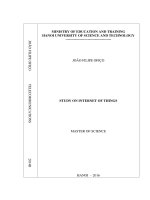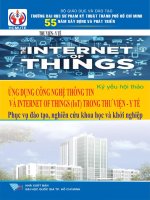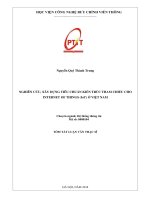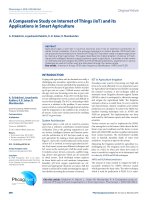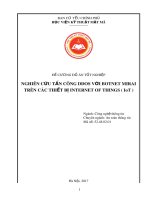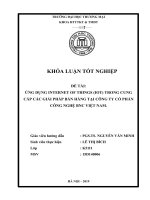survey on internet of things iot towards 5g wireless systems
Bạn đang xem bản rút gọn của tài liệu. Xem và tải ngay bản đầy đủ của tài liệu tại đây (2.9 MB, 18 trang )
<span class="text_page_counter">Trang 1</span><div class="page_container" data-page="1">
ĐẠI HỌC BÁCH KHOA HÀ NỘI
<b>TRƯỜNG ĐIỆN - ĐIỆN TỬ</b>
Supervisor : Ph.D NGUYỄN TIẾN HÒA
</div><span class="text_page_counter">Trang 2</span><div class="page_container" data-page="2">I would like to express my deepest gratitude to Ph.D Nguyen Tien Hoa for hisguidance and support throughout the course of Technical Writing and Presentation. Hisinvaluable insights and instructions have greatly contributed to improving my skills inpresentation delivery, research literature exploration, scientific paper reading, and par-ticularly, the use of LaTeX.
I would also like to extend my sincere appreciation to the template provided by Mr.Nguyen Tien Hoa and Ms. Bui Thi Van. Their template has significantly facilitated thepreparation of this report, making the entire process more efficient and streamlined.
Once again, I am truly thankful to Ph.D Nguyen Tien Hoa for his mentorship andto both Mr. Nguyen Tien Hoa and Ms. Bui Thi Van for their assistance, which have beeninstrumental in the successful completion of this report.
</div><span class="text_page_counter">Trang 3</span><div class="page_container" data-page="3">2.1 Advantages of combining IoT and 5G . . . . 2
2.2 Research Field . . . . 3
2.3 Vision of 5G IoT . . . . 4
<b>CHƯƠNG 3. METHODOLOGY5</b>3.1 Architecture of 5G IoT . . . . 5
3.1.1 IoT Sensor Layer . . . . 5
</div><span class="text_page_counter">Trang 4</span><div class="page_container" data-page="4">4
</div><span class="text_page_counter">Trang 5</span><div class="page_container" data-page="5"><b>LIST OF SIGNS AND ABBREVIATIONS</b>
</div><span class="text_page_counter">Trang 6</span><div class="page_container" data-page="6"><b>LIST OF FIGURES</b>
Figure 2.1 5G IoT Vision from 2005(3G) to 2030(5G) . . . . 4
Figure 3.1 Architecture of 5G IoT . . . . 5
Figure 3.2 Applications of 5G IoT . . . . 8
Figure 4.1 Connecting : Anything, Anyone, Anytime, Anyplace . . . . 9
ii
</div><span class="text_page_counter">Trang 7</span><div class="page_container" data-page="7"><b>LIST OF TABLES</b>
Table 2.1 Industrial and Research Perspective . . . . 3
</div><span class="text_page_counter">Trang 8</span><div class="page_container" data-page="8">The Internet of Things (IoT)-centric concepts like augmented reality, high-resolutionvideo streaming, self-driven cars, smart environment, e-health care, etc. have a ubiqui-tous presence now. These applications require higher data-rates, large bandwidth, in-creased capacity, low latency and high throughput. In light of these emerging concepts,IoT has revolutionized the world by providing seamless connectivity between heteroge-neous networks (HetNets). The eventual aim of IoT is to introduce the plug and playtechnology providing the end-user, ease of operation, remotely access control and con-figurability. This paper presents the IoT technology from a bird’s eye view coveringits statistical/architectural trends, use cases, challenges and future prospects. The paperalso presents a detailed and extensive overview of the emerging 5G-IoT scenario. FifthGeneration (5G) cellular networks provide key enabling technologies for ubiquitousdeployment of the IoT technology. These include carrier aggregation, multiple-inputmultipleoutput (MIMO), massive-MIMO (M-MIMO), coordinated multipoint process-ing (CoMP), device-to-device (D2D) communications, centralized radio access network(CRAN), software-defined wireless sensor networking (SD-WSN), network function vir-tualization (NFV) and cognitive radios (CRs). This paper presents an exhaustive reviewfor these key enabling technologies and also discusses the new emerging use cases of5G-IoT driven by the advances in artificial intelligence, machine and deep learning, on-going 5G initiatives, quality of service (QoS) requirements in 5G and its standardizationissues. Finally, the paper discusses challenges in the implementation of 5G-IoT due tohigh data-rates requiring both cloud-based platforms and IoT devices based edge com-puting.
iv
</div><span class="text_page_counter">Trang 9</span><div class="page_container" data-page="9"><b>CHAPTER 1. INTRODUCTION</b>
The Internet of Things (IoT) and 5G wireless systems are two emerging gies that have gained significant attention and witnessed rapid development in recentyears. IoT refers to a network of interconnected devices and objects embedded with sen-sors, software, and connectivity capabilities, enabling them to collect and exchange data.On the other hand, 5G wireless systems represent the next generation of mobile com-munication networks, promising faster data transmission, lower latency, and increasedcapacity.
technolo-The convergence of IoT and 5G has the potential to revolutionize various sectors,including healthcare, transportation, manufacturing, and smart cities. The combinationof IoT devices and 5G networks can enable real-time data processing, seamless connec-tivity, and enhanced communication between devices, paving the way for innovative ap-plications and services. For instance, in healthcare, IoT devices can gather patient data,transmit it over 5G networks to healthcare professionals, and enable remote monitoringand diagnosis.
The motivation behind researching the relationship between IoT and 5G lies inthe need to explore the synergistic effects and benefits that arise from their integration.By harnessing the capabilities of 5G networks, IoT devices can overcome some of thelimitations of existing wireless technologies, such as bandwidth constraints and highlatency. Additionally, the scalability and flexibility of IoT can greatly benefit from thehigh-speed and low-latency communication offered by 5G.
Understanding the potential of IoT in the context of 5G wireless systems is crucialfor researchers, industry professionals, and policymakers. By examining the currentstate of development and applications of IoT and 5G, this report aims to shed light onthe opportunities, challenges, and future prospects of this convergence. The findingsand insights obtained from this research will contribute to the ongoing discussions andadvancements in the field, ultimately facilitating the deployment and adoption of IoTwithin 5G networks.
</div><span class="text_page_counter">Trang 10</span><div class="page_container" data-page="10"><b>CHAPTER 2. LITERATURE REVIEW</b>
<b>2.1 Advantages of combining IoT and 5G</b>When searching for literature and research papers on IoT and 5G, we can observethe benefits as well as the challenges in this field :
•1-10 GBPS data rate in real time networks: the data transfer must be 10X more thanthat of existing technologies [1].
•Low latency > 10ms: latency must be 10X smaller as compared to LTE networks[2].
•High bandwidth and spectrum efficiency: 5G technologies require high bandwidthand it can be achieved through the use of MIMO antenna and mm wave technologiesand spectrum efficiency can be achieved by cognitive radio which allows the userto utilize both the licensed and unlicensed spectrum bands [3].
•Low cost: IoT should feature with low cost sensors, devices and their deploymentcost should be low.
•More number of connected devices: As we are dealing with IoT system and isexpected around 80 billion IoT devices are connected over a network.
•Longer battery life: As the devices are expected to be smart and it requires morepower consumption and the charge storage and battery backup should me more [4].•Reduce energy consumption by almost 90 percent: reduction of energy in 5G tech-nologies can be achieved by deployment of green technologies and it can be effi-cient in massive connectivity and high data rates.
2
</div><span class="text_page_counter">Trang 11</span><div class="page_container" data-page="11">all the devices from IoT platform are connected to each other.The active cooperation is key requirements in realizing 5G IoTareas such as smart homes, smart cities, smart factories, smarthealthcare, smart agriculture, logistics etc. Samsung is providing
extensive contribution in IoT open cloud platform that enablesusers to control over home appliances. Samsung electronics
gadgets like AC, Washing machine, Refrigerator can becontrolled by remote.
Intel has been the global pioneering in deployment of sub 6 GHzand mm wave communication, so that industry ecosystem acrossthe world can develop 5G service solutions. Intel is developing a
new critical technology that enables 5G HetNets andmaximizing efficient use of spectrum resources. Intel is working
on recent technologies such as licensed accessed access (LAA)that can boost speed performance.
the major contribution of ZTE in IoT industry. ZTE has madeoutstanding achievement with its quality cloud based networks. .
ZTE has found patents on some new technologies such asFBMC, Wireless security and low power consumption. ZTE has
research collaboration with leading service provider like KoreaTelecom, China Telecom and China mobile. ZTE is actively
</div><span class="text_page_counter">Trang 12</span><div class="page_container" data-page="12">nies and service providers with excellent research facilities are conducting research andfield trials to provide the accessibility of 5G wireless technology by 2030. Some researchinstitution with world class laboratory facilities are engaged in 5G research and experi-ments. The latest advancement and up gradation in cellular technology promises to meetthe demand of faster internet speeds, better spectrum efficiency, long distance commu-nication, better battery life and communicating billions of devices. IoT in 5G frameworkcan be the most revolutionary technology in field of information technology. Accordingto research, 5G wireless technology will be accessible in many countries within 2030.
<b>2.3 Vision of 5G IoT</b>
<b>Figure 2.1 5G IoT Vision from 2005(3G) to 2030(5G)</b>
The use of IoT services and number of connecting devices within a network anddevice connected per person is shown in figure 2.1 and is expected around 80 billiondevices will be connected within in a network and 20.5 billion devices will be connectedper person by 2030 as shown in figure 2.1. The technology of IoT and 5G is transformingand bringing industrial revolution 4.0 in every aspects of technological era. The IoT canbe developed with the concepts like machine to machine (M2M), device to device (D2D),vehicle to vehicle (V2V), and vehicle to anything (V2A), where every convenience istaken by the interconnected devices, sensors and communication networks. IoT maybe used in different field of life changing applications such as smart factories, smarthospitals, smart transportation, smart agriculture, smart homes and cities etc.
4
</div><span class="text_page_counter">Trang 13</span><div class="page_container" data-page="13"><b>CHAPTER 3. METHODOLOGY</b>
<b>3.1 Architecture of 5G IoT</b><b>Figure 3.1 Architecture of 5G IoT</b>
IoT in a 5G framework mainly comprises of five layered architecture as shown infig 3.1 and involves the operation of collecting data, processing, analyzing and sharingthe information between the devices and communication network.
3.1.1 IoT Sensor Layer
This layer consists of physical layer system such as smart sensors, devices andcommunicates to the network layer.
3.1.2 Network Layer
This layer can be considered as the backbone of IoT architecture because it transfersthe whole information within the layers.
3.1.3 Architecture Layer
</div><span class="text_page_counter">Trang 14</span><div class="page_container" data-page="14">tion over wireless connectivity using internet. The pictorial representation of 5G IoTarchitecture in shown in figure 3.1.
<b>3.2 Enabling techology driver in different layers of 5G IoT</b>
3.2.1 Sensor Layer
Everywhere we look, technological evolution is surrounding us. Advancement insemiconductor industries, electronic device and automation solutions are driving thegrowth in smart sensors. The smart sensors are the combination of sensors and interfac-ing unit. The smart sensors are capable of two way communication between the sensorsand network layers and make their communication and make the decisions. The sensorslayer in IoT performs a machine type communication (MTC) and communicates with thenetwork layer. Smart sensors have numerous advantages over conventional sensor suchas:
•Smart Communication between Devices, Sensors, and Network Protocols•Lesser Cable communication.
•Installation and maintenance are easy.•Flexible Connection.
•Low Cost and Power.
•High Reliability band efficient performance.3.2.2 Network Layer
In 5G, the requirement in network layer is to provide low power and long range nectivity in IoT applications. Multiple connections are possible to achieve massive IoTand critical IoT connectivity through low power wide area networks (LPWAN). LPWAtechnology are mainly used in IoT applications because of their unique features suchas wide area coverage, low power consumption, better energy efficiency and high datarates.
con-3.2.3 Communication Layer
In communication layer, 5G uses Radio access technology (RAT) in IoT tions. 5G new radio (NR) is an effort of 3GPP to develop the standard for next generationwireless communication technology [5]. 5G NR is specified as per 3GPP release 15 andrelease 16 standardization. 5G new radio technology is a part of radio access technology(RAT) which is composed of LTE and 5G NR. 5G NR technology are operational insub 6 GHz and 20-100 GHz (mm wave range. A variety of complex technologies likeNR supported IoT including massive MIMO, waveforms and frame structure; coding
applica-6
</div><span class="text_page_counter">Trang 15</span><div class="page_container" data-page="15">and mm wave radio frequencies are to be considered. Radio access provides both portunities and complexity in RAN structure particularly in IoT platform such as, smartfactories, critical services and other applications. 5G NR access technology will facil-itate market opportunities for small base station, small cells like pico cells and femtocells and smart sensors for different IoT applications. NR uses scalable numerology andmixed numerology where carrier spacing is given by :
Here ‘µ’ in the 3.1 is the numerology. It is an integer that depends upon the type of vice requirements. Numerology value ranges from -2 to 4.In scalable numerology, intersub carrier spacing interference in highly reduced due to the use of single numerologyvalue at a time where as in mixed numerology the problem arises with the sub carrierspacing due to multiple numerology usage
ser-3.2.4 Architecture Layer
n 5G IoT, cloud based architecture is more preferred because Cloud technology isthe most trending technology in IoT and is mainly associated to information technol-ogy (IT) services and can be extended to embedded system programming. The cloudarchitecture devices such as PCs, smartphone, laptops, and host machines are deployedinto cloud. Cloud technology in IoT is architecture for ubiquitous services that can bedelivered to the users with minimum service management with better efficiency. Since,IoT exist with big data and they are managed through cloud. It is an internet basedcomputing where services like servers, data storage, login, registration user interface,Authentication, and application are delivered through cloud internet. Generally thereare three basic models of cloud computing and are discussed below:
•Infrastructure as a Service (IaaS)•Platform as a Service (Paas)•Software as Service (SaaS)3.2.5 Application Layer
5G MTC provides a wide range of applications. In future generation wireless
</div><span class="text_page_counter">Trang 16</span><div class="page_container" data-page="16"><b>tech-Figure 3.2 Applications of 5G IoT</b>
•Smart Home : The other major application of 5G IoT is smart homes. The futuregeneration wireless technology allows the household appliances to be connectedbetween them.
•E-Healthcare : Health care is the other major sector where maximum priority hasto be given. As there is a saying “Health is Wealth”, considering this saying,telemedicine is the most trending technology to provide improvements in healthsector
•Smart Transportation : Smart transportation, popularly termed as intelligent portation systems (ITS) is one of the typical applications of 5G internet of things(IoT).
trans-•Smart Factories : Smart factory is the other important application of IoT. It is ceptualized as industrial revolution 4 and we see that all the activities are governedby digital technologies
con-8
</div><span class="text_page_counter">Trang 17</span><div class="page_container" data-page="17"><b>CHAPTER 4. RESULTS AND CONCLUSION</b>
<b>Figure 4.1 Connecting : " Anything, Anyone, Anytime, Anyplace</b>
The vision and mission of 5G IoT is to connect multiple numbers of devices withinthe same network architecture. Many advance applications in 5G wireless applicationlike smart cities, internet of vehicle (IoV), smart factories, smart agriculture and smarthealthcare leads to IoT revolution. [6], [7] Such huge ranges of smart applications areexpected to be supported with high speed massive connectivity under the same roof of5G wireless communication. The new architecture in 5G IoT is proposed that includesNew Radio (NR), MIMO, mm wave communication and cloud computing. We madea complete review on 5G revolution and highlighted some of the key technologies inIoT context. Finally, we provided some research challenges and research direction onthis revolutionary technology. We also made some reviews on how and what kind of re-searches are conducting by industries in 5G domain. In future, 5G and beyond activities
</div>
